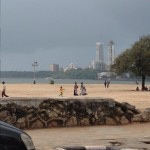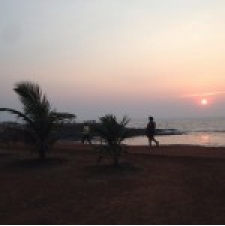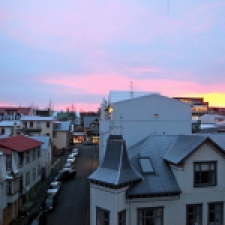Finding Nemo
01 May 2017In a gentle curve down the right of the road of my childhood home is a sectioned off piece of dense forest dropping off onto thick soft sand. The sea begins there, or anywhere, even here where I stand, nearly 2000 kilometres away. Named Governor’s Beach it is has restricted access, is attached to a heritage bungalow in which the serving Governor of Mumbai resides, and demarcates an outstanding outline to the south-most end of Bombay, the city of my youth. The city that spoilt me for any other city (yes, even New York).

Across the water at the edge of the green is the Governor’s Beach.
Originally a series of seven islands, Bombaim was named after the Portuguese for good little bay, owing to its excellent position for trade, calm water and lush greenery. Anglicized to Bombay by the British in the 17th century and back to its humble start from the protective goddess Mumba Devi, the supreme deity of the island’s first fisher folk, the Koli people, Mumbai is now the world’s most populated city. Estimated to contain 20 million people, the city implodes with chaotic rage, supreme self-confidence and a maddening chutzpah unlike any other. This frenetic life within it is tempered by the ever present Arabian Sea. Benevolent, balancing, restorative to the pace of life on shore.

Bombay and water: nothing without the other.
When I moved out of Bombay in 1997 I did not realize how deeply the constant presence of the sea affected me. Living later in hill-locked Sheffield, land-locked Leicester and then London (ok there’s the Thames, but let’s not compare our water according to volume: vastness always wins) confused me for a few early years. What was this incomprehensible anguish reverberating inside me? Why did I feel a sluice of sadness despite being busy, having fun, doing cool stuff in dynamic places? Were the parks and lakes not enough – filled with birdsong in spring? Only when I moved to New York did I understand the magnitude of the magnetic draw of the sea, the ocean. The windows of my 29th floor apartment in Hell’s Kitchen overlooking the Hudson (by this time really not a river as it empties itself into the Atlantic Ocean) perfectly framed the massive ocean liners coming in to dock at Manhattan’s west-side. Looking out onto that vista, that strange longing seemed to ease, quietly ebbing away with the flow of my days in that neighborhood. Even when I moved out of that apartment into a ground floor hole-in-wall in the West Village, the water in NYC, much like the sea in Bombay, was always a short walk down the street, shimmering in the late afternoon sun across its infamous skyline.

Sunset over Hell’s Kitchen in Manhattan.
This strong kinship with expansive amounts of water sustained me through my years in Reykjavik. The northern-most capital of the world, the city stands as testament to human’s stubborn endeavor to inhabit some of the most inhospitable land on earth. Its west coast position (like Bombay) ensures crimson sunsets in autumn (when the sun does peek through), and in winter, stark snow-capped mountains rising like vicious Vikings from a raging Atlantic Ocean. Reykjavik is one of the most achingly beautiful cities on this planet. It took my breath away driving down its narrow streets straight to the edge of the ocean on a clear summer’s day when the water betrayed nothing but serene cyan. Other times, it seethed icy anger, crashing into the isolated island, alone in the North Atlantic.

Downtown Reykjavik, a few streets from where I lived.
It’s no surprise then that moving to another city at the world’s water’s edge made the transition to Dubai that much easier. Here the sea is not the sea as much as it’s a manipulation by man to squeeze it into fancy named stuff like ‘creek’, ‘marina’, and ‘palm’. These are inlets off the ports and shore, converting arid areas into highly marketed built up and crazily coveted residential space, packed to the gills with restaurants, condominiums, expensive hotels and the biggest draw – the beaches (often made from readily available sand a couple of kilometers into the desert). If you erase the hype, naturally occurring water is rare. Where it exists, it remains breathtaking, as always.

Dubai’s Jumeira beach with the Burj al Arab as sentinel.
The trouble with sea laced city dwellers is their astounding nonchalance for the extreme good fortune literally lapping at their laps. Take away the immediacy of ocean surrounding these cities. Empty those shores. Redirect the water. Now they will know what it feels like not to have its constant presence in their life. Remove those stunning sunsets, the whoosh of waves, the good fortune of fish for trade. Give them land and more land, perhaps trees, small bodies of water like lakes (these would be man-made in Dubai), squeeze them between a mountain or two to confine their city’s growth. Make them claustrophobic. No restorative escape to any ocean or sea. Will they survive? Perhaps. Will they thrive? Perhaps not.
 0 comments
0 comments

